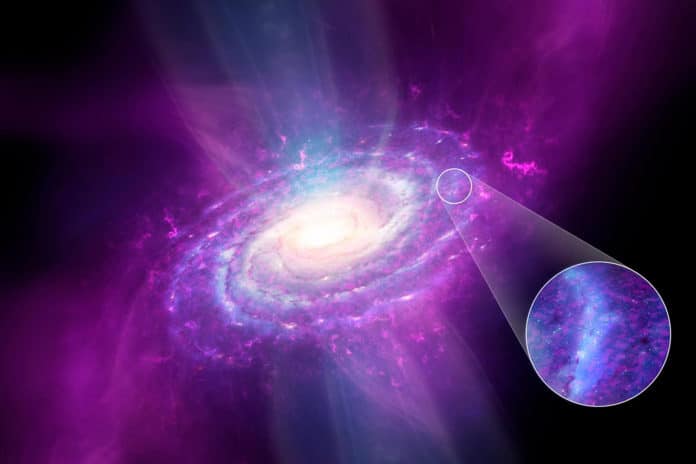Until now, hypothetical models expected that three elements- the gas coming from outside our galaxy, the gas inside our galaxy, and the dust created by the condensation of the metals present in this gas were homogeneously blended all through the Milky Way. But a new study from a team of astronomers from the University of Geneva (UNIGE) demonstrates that these gases are not homogeneously mixed.
Based on the hypothetical models, astronomers assume that these three elements must have reached a level of chemical enrichment similar to the Sun’s atmosphere, called the Solar metallicity. This new study contradicts that belief, suggesting these gases are not mixed as much as previously thought. The findings have a substantial impact on the current understanding of the evolution of galaxies.
The study is an attempt to understand the history and evolution of the Milky Way. While studying the composition of the gases and metals that make up an essential part of our galaxy, three main elements stand out: the initial gas coming from outside our galaxy, the gas between the stars inside our galaxy – enriched with chemical elements –, and the dust created by the condensation of the metals present in this gas.
Annalisa De Cia, a professor in the Department of Astronomy at the UNIGE Faculty of Science and first author of the study, said, “Galaxies are fuelled by ‘virgin’ gas that falls in from the outside, which rejuvenates them and allows new stars to form. At the same time, stars burn the hydrogen that constitutes them throughout their life and forms other elements through nucleosynthesis. When a star that has reached the end of its life explodes, it expels the metals it has produced, such as iron, zinc, carbon, and silicon, feeding these elements into the gas of the galaxy. These atoms can then condense into dust, especially in the colder, denser parts of the galaxy.”
“Initially, when the Milky Way was formed, it had no metals more than 10 billion years ago. Then the stars gradually enriched the environment with the metals they produced”, continues the researcher. When the amount of metals in this gas reaches the level that is present in the Sun, astronomers speak of Solar metallicity.”
Patrick Petitjean, a researcher at the Institut d’Astrophysique de Paris, Sorbonne University, said, “Until now, theoretical models considered that these three elements were homogeneously mixed and reached the Solar composition everywhere in our galaxy, with a slight increase in metallicity in the center, where the stars are more numerous. We wanted to observe this in detail using an Ultraviolet spectrograph on the Hubble Space Telescope.”
“Spectroscopy allows the light from stars to be separated in its colors or frequencies. When we observe a star, the metals that make up the gas between the star and ourselves absorb a very small part of the light characteristically, at a specific frequency, which allows us not only to identify their presence but also to say which metal it is, and how abundant it is.”
For this study, astronomers observed the atmosphere of 25 stars for 25 hours. They used Hubble and the Very Large Telescope (VLT) in Chile for this task.
But the issue was that the dust could not be counted with these spectrographs. Hence, astronomers developed a new observational technique that considers the total composition of the gas and dust by simultaneously observing several elements such as iron, zinc, titanium, silicon, and oxygen.
Through this technique, the team was able to trace the quantity of metals present in the dust. They then added it to that already quantified by the previous observations to get the total.
Along with showing that the Milky way’s environment is not homogenous, the technique also shows that the areas studied reach only 10% of the solar metallicity.
Jens-Kristian Krogager, a researcher at the UNIGE’s Department of Astronomy, said, “This discovery plays a key role in the design of theoretical models on the formation and evolution of galaxies. From now on, we will have to refine the simulations by increasing the resolution so that we can include these changes in metallicity at different locations in the Milky Way.”
Journal Reference:
- De Cia, A., Jenkins, E.B., Fox, A.J. et al. Large metallicity variations in the Galactic interstellar medium. Nature 597, 206–208 (2021). DOI: 10.1038/s41586-021-03780-0
